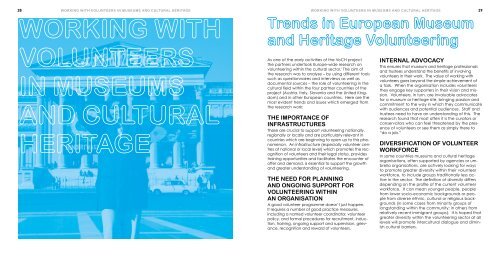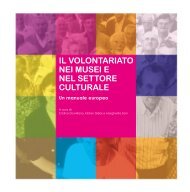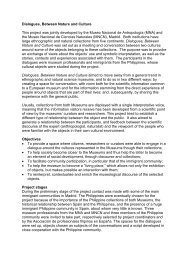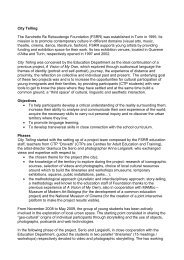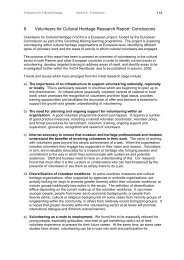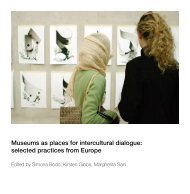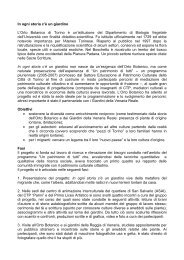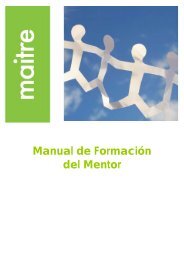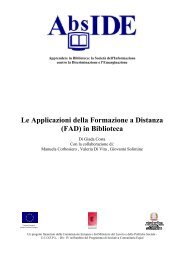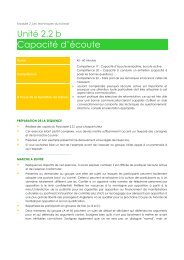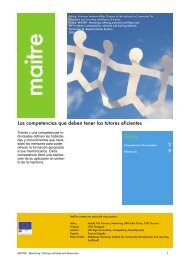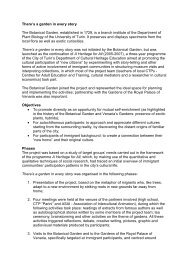26 EUROPEAN CONTEXTS FOR <strong>CULTURAL</strong> VOLUNTEER<strong>IN</strong>GEUROPEAN CONTEXTS FOR <strong>CULTURAL</strong> VOLUNTEER<strong>IN</strong>G27The European Museum Forum held a workshop formuseum professionals 17-21 October 2007 at theUniversity Residential Centre in Bertinoro, Italy. 2 Thesubject, volunteers in cultural heritage and museums,helped to shape and inform the work of theVoCH project.The workshop viewed volunteering from two perspectives:recognising both the important contributionvolunteers can make to the running of culturalorganisations, heritage attractions and museums,and also the significant impact that such voluntaryactivity can have on the people involved in termsof personal and professional growth.The objective was to share experiences and exchangeideas on how to recruit, motivate andmanage volunteers in the cultural heritage sectorand how to conceive training and developmentprogrammes which are beneficial for the individualsinvolved and contribute to their personal andprofessional growth. The conclusions of the participantsrepresent the results of three intensive daysof keynote presentations, debate and discussion. Itis the hope of the participants that the conclusionswill have relevance to cultural professionals andpolicy-makers throughout Europe. The large amountof material resulting from discussions and case studieshas been summarised in the ten recommendationsbelow which are intended to offer a platformfor coherent action in the field of volunteering forcultural heritage in Europe with a special accent onthe museum field, where this involvement is felt tobe of strategic value for the growth, if not even forthe survival of many institutions.1General Recommendations1. Volunteers can be an important, inspiring labourand advocacy force for museums, deeply embeddedin the European tradition. Volunteers can provideknowledge, experience and inspiration, bring newperspectives on museum collections, and help to developnew audiences. Volunteers can strengthen themuseum’s relationship with its local or regional environmentas ambassadors of the institution.2. In discussions on the European level about the roleof volunteers we must bear in mind the huge differencesbetween regions and countries in the areas ofculture, legislation, formal education and social security;these can confuse the exchange of experiencesbetween countries and may even include differentmeanings of the word volunteer.3. The position of volunteer work in museums and culturalorganisations may be considered within with thewhole spectrum of staff requirements and opportunities,including core staff roles, internships, reintegrationprogrammes, education programmes and specialprojects.4. In order to optimise the value and position of volunteerwork in museums, it should be an explicit andintegrated part of policy and human resource management.In order to devise a relevant and workablevolunteer programme, the museum must considerits mission as well as operational needs and wishes. Itmust also achieve the commitment and support ofthe existing staff.5. A successful volunteer programme requires the institutionto recognise and consider the motivations andneeds of the individual volunteer. These will vary fromindividual to individual, but factors to consider includeage, stage of life and social background. Volunteerscan gain knowledge, learn new skills, increase theirvalue on the labour market, enhance their social wellbeingor status, and receive formal or informal recognitionas a benefit of volunteering.6. In considering the cost of setting up and runninga volunteer programme, the museum needs to bearin mind the necessary investment of financial andpersonnel resources required for recruitment, marketing,communication, training, reimbursements andincentives. There are costs associated with running avolunteer programme and volunteers should not beseen as a form of cheap labour.7. Recruitment, training, integration and retention ofvolunteers, as for permanent or paid staff, require regularcare and attention. The appointment of a volunteercoordinator is recommended to develop and managethe volunteer programme and to mediate between allstakeholders within the museum organisation.8. The quality of a museum’s volunteer programmecan be an indication of the museum’s quality as awhole. Attractive museums, with a strong focus ontheir public, will be more successful in attracting goodquality, skilled volunteers.9. The relationship between the volunteer and theorganisation should be based on the principle ofshared values, be reciprocal and be formalised in acontract or other document defining the volunteer’srole and setting out mutual obligations, rights, expectationsand limitations.10. Within a well-developed programme, volunteersshould be viewed as full members or stakeholders ofthe organisation, with the ability to state their viewsand influence decision-making. They should not beseen as a threat to professionalism, the position of regularstaff or the continuity of the organisation, ratherthey should be seen to enhance these areas.In conclusionFor the benefit of cultural exchange and improvementof cultural awareness on the European level, itis recommended that the work of volunteers in thecultural sector be stimulated and opportunities createdto exchange experiences of museums and othercultural institutions.The participants in the 2007 EMF Workshop expressedthe wish to continue such exchange at a distance,possibly relying on the research outcomes and on thetools which will be developed by European projects,such as Volunteers for Cultural Heritage, as well as onthe network it will establish over the two years of itsduration.NOTE1 - This text has been abridged slightly for this publication. Thefull text and a list of workshop participants can be downloadedfrom http://www.amitie.it/voch/conclusioni.pdf andhttp://assembly.coe.int/Museum/ForumEuroMusee/Workshop/workshop_Index.asp2 - In co-operation with: The Istituto Beni Culturali RegioneEmilia-Romagna, Bologna, and the Cultural Department of theRegione Toscana, Florence and under the auspices of the Councilof Europe. Participation was supported by Grundtvig mobilitygrants (EU Lifelong Learning Programme)
28 WORK<strong>IN</strong>G WITH <strong>VOLUNTEERS</strong> <strong>IN</strong> <strong>MUSEUMS</strong> <strong>AND</strong> <strong>CULTURAL</strong> <strong>HERITAGE</strong> WORK<strong>IN</strong>G WITH <strong>VOLUNTEERS</strong> <strong>IN</strong> <strong>MUSEUMS</strong> <strong>AND</strong> <strong>CULTURAL</strong> <strong>HERITAGE</strong> 29As one of the early activities of the VoCH projectthe partners undertook Europe-wide research onvolunteering within the cultural sector. 1 The aim ofthe research was to analyse – by using different toolssuch as questionnaires and interviews as well asdocumental sources – the role of volunteering in thecultural field within the four partner countries of theproject (Austria, Italy, Slovenia and the United Kingdom)and in other European countries. Here are themost evident trends and issues which emerged fromthe research work:The importance ofinfrastructuresThese are crucial to support volunteering nationally,regionally or locally and are particularly relevant incountries which are beginning to open up to this phenomenon.An infrastructure (especially volunteer centresat national or local level) which promotes the recognitionof volunteers and their legal status, providestraining opportunities and facilitates the encounter ofoffer and demand, is essential to support the growthand greater understanding of volunteering.The need for planningand ongoing support forvolunteering withinan organisationA good volunteer programme doesn’t just happen.It requires a number of good practice measures,including a named volunteer coordinator, volunteerpolicy, and formal procedures for recruitment, induction,training, ongoing support and supervision, grievance,recognition and reward of volunteers.Internal advocacyThis ensures that museum and heritage professionalsand trustees understand the benefits of involvingvolunteers in their work. The value of working withvolunteers goes beyond the simple achievement ofa task. When the organisation includes volunteersthey engage key supporters in their vision and mission.Volunteers, in turn, are invaluable advocatesfor a museum or heritage site, bringing passion andcommitment to the way in which they communicatewith audiences and potential audiences. Staff andtrustees need to have an understanding of this. Theresearch found that most often it is the curators orconservators who can feel threatened by the presenceof volunteers or see them as simply there to“do a job.”Diversification of volunteerworkforceIn some countries museums and cultural heritageorganisations, often supported by agencies or umbrellaorganisations, are actively looking for waysto promote greater diversity within their volunteerworkforce, to include groups traditionally less activein the sector. The definition of diversity differsdepending on the profile of the current volunteerworkforce. It can mean younger people, peoplefrom lower socio-economic backgrounds or peoplefrom diverse ethnic, cultural or religious backgrounds(in some cases from minority groups oflongstanding within the community; in others fromrelatively recent immigrant groups). It is hoped thatgreater diversity within the volunteering sector at alllevels will promote intercultural dialogue and diminishcultural barriers.


